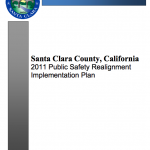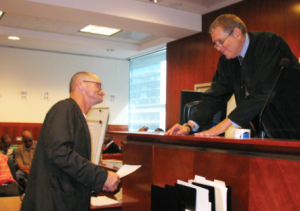
The Santa Clara Realignment Model: This model builds on a comprehensive collaborative court system, well established in Santa Clara County over the past fifteen years. It probably is closer to an evidence-based “Court-involved Realignment Model” than any other in California. Conceptually, the Model attempts to use the reentry court to separate the high risk offenders (many with histories of violence), from the felons who pose little threat to the community.[click on image on the left for the 2011 Santa Clara County Public Safety Realignment implementation Plan]
Under the leadership of Judge Stephen Manley, Santa Clara County has been able to expand and provide coverage beyond drug offenders to veterans, the mentally ill, parolees and other criminal justice populations, working with over 2000 offenders a year. It was natural for Santa Clara County’s Probation Department to work closely with the county’s Collaborative Court System to assist both supervision and rehabilitation of AB109 Realignment participants:
1. Offenders sentenced as felons under 1170H, (known as triple nons; non-violent, non-serious, non sex-ofenders) are assessed early in the process, so that twelve sentencing judges can determine high risk offenders who need the special attention of the reentry court.
2.Probation often refers parole violators (triple nons released from prison on Post Release Community Supervision; PRCS) to the Parole Reentry Court for closer supervision and rehabilitation, even before filing a petition to revoke. Using a retired treatment judge as the AB109 Revocation Hearing Officer, the Court retains PRCS offenders for special attention, while referring others to the Parole Reentry Court or other alternative to jail (if not to jail itself).
3. Finally, parolees supervised by parole officers, are turned over to the Parole Board for revocation hearings and sanctions (to be taken over by the Realignment Revocation Officer come July 2013). Parole currently sends a significant number of high risk parolees to the Parole Reentry Court for supervision and rehabilitation services.
There are over 200 AB109 participants among the three categories of AB109 offenders presently being supervised by a reentry court (with some estimating the number to double over the next year).
The 2012 Santa Clara County Realignment Implementation Plan is expected to be submitted to the Board of Supervisors shortly.
[published in October, 2012]



